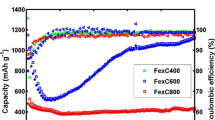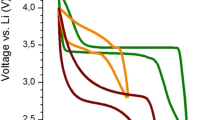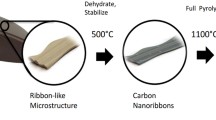Abstract
The carbon cloth (CC)–supported Prussian blue (PB) composite was firstly prepared by using CC as the substrate and PB as active material through a solution impregnation method. Then, the Fe2O3/CC material was obtained by the subsequent high-temperature calcination of PB/CC. This is the first example of composites based on CC and PB (or PB analogues)-derived metal oxides. The resulting Fe2O3/CC composite can be employed directly as binder-free anodes for lithium-ion batteries (LIBs), exhibiting superior electrochemical performances to pure CC and Fe2O3. The mass specific capacity of Fe2O3/CC was about 395 mA h g−1 (an areal capacity of 5.1 mA h cm−2) at 100 mA g−1 with almost no decay after 135 discharge/charge cycles. The outstanding lithium storage properties of Fe2O3/CC benefit from the synergistic interaction between CC and Fe2O3.









Similar content being viewed by others
References
Cao XH, Zheng B, Rui XH, Shi WH, Yan QY, Zhang H (2014) Metal oxide-coated three-dimensional graphene prepared by the use of metal-organic frameworks as precursors. Angew Chem Int Ed 53:1404–1409
Catala L, Mallah T (2017) Nanoparticles of Prussian blue analogs and related coordination polymers: from information storage to biomedical applications. Coord Chem Rev 346:32–61
Chen T, Hu Y, Cheng BR, Chen RP, Lv HL, Ma LB, Zhu GY, Wang YR, Yan CZ, Tie ZX, Jin Z, Liu J (2016) Multi-yolk-shell copper oxide@carbon octahedra as high-stability anodes for lithium-ion batteries. Nano Energy 20:305–314
Feng JH, Zhou H, Wang JP, Bian T, Shao JX, Yuan AH (2018) MoS2 supported on MOF-derived carbon with core-shell structure as efficient electrocatalysts for hydrogen evolution reaction. Int J Hydrog Energy 43:20538–20545
Goodenough JB, Park KS (2013) The Li-ion rechargeable battery: a perspective. J Am Chem Soc 135:1167–1176
Hu L, Zhang P, Zhong H, Zheng XR, Yan N, Chen Q (2012) Foamlike porous spinel MnxCo3-xO4 material derived from Mn3[Co(CN)6]2·nH2O nanocubes: a highly efficient anode material for lithium batteries. Chem Eur J 18:15049–15056
Huang G, Zhang FF, Du XC, Qin YL, Yin DM, Wang LM (2015) Metal organic frameworks route to in situ insertion of multiwalled carbon nanotubes in Co3O4 polyhedra as anode materials for lithium-ion batteries. ACS Nano 9:1592–1599
Huang LY, Wang X, Yin FX, Zhang CW, Gao JW, Liu JM, Zhou GF, Zhang YG, Bakenov Z (2017) Three-dimensional carbon cloth-supported ZnO nanorod arrays as a binder-free anode for lithium-ion batteries. J Nanopart Res 19:42
Ji D, Zhou H, Zhang J, Dan YY, Yang HX, Yuan AH (2016) Facile synthesis of metal-organic framework-derived Mn2O3 nanowires coated three-dimensional graphene network for high-performance free-standing supercapacitor electrodes. J Mater Chem A 4:8283–8290
Ji D, Zhou H, Tong YL, Wang JP, Zhu MZ, Chen TH, Yuan AH (2017) Facile fabrication of MOF-derived octahedral CuO wrapped 3D graphene network as binder-free anode for high performance lithium-ion batteries. Chem Eng J 313:1623–1632
Jiang TC, Bu FX, Feng XX, Shakir I, Hao GL, Xu YX (2017) Porous Fe2O3 nanoframeworks encapsulated within three-dimensional graphene as high-performance flexible anode for lithium-ion battery. ACS Nano 11:5140–5147
Kobayashi Y, Abe J, Kawase K, Takahashi K, Vogt BD, Shiratori S (2018) Enhanced stability of smoothly electrodeposited amorphous Fe2O3@electrospun carbon nanofibers as self-standing anodes for lithium ion batteries. New J Chem 42:1867–1878
Li M, Lu J, Chen ZW, Amine K (2018) 30 years of lithium-ion batteries. Adv Mater 1800561
Liao KX, Chen ST, Wei HH, Fan JC, Xu QJ, Min YL (2018) Micropores of pure nanographite spheres for long cycle life and high-rate lithium-sulfur batteries. J Mater Chem A 6:23062–23070
Lin LY, Li QB, Nie SY, Peng XH, Hu N (2016) 3D ZnCo2O4 nanowires@MnO2 nanosheets core-shell structures grown on carbon cloth for excellent supercapacitor electrodes. Ceram Int 42:19343–19348
Luo DW, Lin F, Xiao WD, Zhu WD (2017) Synthesis and electrochemical performance of α-Fe2O3@carbon aerogel composite as an anode material for Li-ion batteries. Ceram Int 43:2051–2056
Lv XX, Deng JJ, Wang BQ, Zhong J, Sham TK, Sun XH, Sun XL (2017) γ-Fe2O3@CNTs anode materials for lithium ion batteries investigated by electron energy loss spectroscopy. Chem Mater 29:3499–3506
Meng JK, Fu L, Liu YS, Zheng GP, Zheng XC, Guan XX, Zhang JM (2017) Gas-liquid interfacial assembly and electrochemical properties of 3D highly dispersed α-Fe2O3@graphene aerogel composites with a hierarchical structure for applications in anodes of lithium ion batteries. Electrochim Acta 224:40–48
Nie P, Shen L, Luo HF, Ding B, Xu GY, Wang J, Zhang XG (2014) Prussian blue analogues: a new class of anode materials for lithium ion batteries. J Mater Chem A 2:5852–5857
Pramudita JC, Schmid S, Godfrey T, Whittle T, Alam M, Hanley T, Brand HEA, Sharma N (2014) Sodium uptake in cell construction and subsequent in operando electrode behaviour of Prussian blue analogues, Fe[Fe(CN)6]1-x·yH2O and FeCo(CN)6. Phys Chem Chem Phys 16:24178–24187
Qiu WT, Balogun MS, Luo Y, Chen KQ, Zhu YK, Xiao XJ, Lu XH, Liu P, Tong YX (2016) Three-dimensional Fe3O4 nanotube array on carbon cloth prepared from a facile route for lithium ion batteries. Electrochim Acta 193:32–38
Shan XY, Zhang S, Zhang N, Chen YJ, Gao H, Zhang XT (2018) Synthesis and characterization of three-dimensional MoS2@carbon fibers hierarchical architecture with high capacity and high mass loading for Li-ion batteries. J Colloid Interf Sci 510:327–333
Shao JX, Feng JH, Zhou H, Yuan AH (2019) Graphene aerogel encapsulated Fe-Co oxide nanocubes derived from Prussian blue analogue as integrated anode with enhanced Li-ion storage properties. Appl Surf Sci 471:745–752
Tjandra R, Li G, Wang XL, Yan J, Li M, Yu A (2016) Flexible high performance lithium ion battery electrode based on a free-standing TiO2 nanocrystals/carbon cloth composite. RSC Adv 6:35479–35485
Wang XH, Zhang M, Liu EZ, He F, Shi CS, He CN, Li JJ, Zhao NQ (2016) Three-dimensional core-shell Fe2O3@carbon/carbon cloth as binder-free anode for the high-performance lithium-ion batteries. Appl Surf Sci 390:350–356
Wang XF, Tang YH, Shi PH, Fan JC, Xu QJ, Min YL (2018a) Self-evaporating from inside to outside to construct cobalt oxide nanoparticles-embedded nitrogen-doped porous carbon nanofibers for high-performance lithium ion batteries. Chem Eng J 334:1642–1649
Wang JP, Zhou H, Zhu MZ, Yuan AH, Shen XP (2018b) Metal-organic framework-derived Co3O4 covered by MoS2 nanosheets for high-performance lithium-ion batteries. J Alloy Compd 744:220–227
Wei X, Li WH, Shi JA, Gu L, Yu Y (2015) FeS@C on carbon cloth as flexible electrode for both lithium and sodium storage. ACS Appl Mater Interfaces 7:27804–27809
Xie QX, Zhang YF, Zhu YT, Fu WG, Zhang X, Zhao P, Wu SH (2017) Graphene enhanced anchoring of nanosized Co3O4 particles on carbon fiber cloth as free-standing anode for lithium-ion batteries with superior cycling stability. Electrochim Acta 247:125–131
Xiong QQ, Tu JP, Xia XH, Zhao XY, Gu CD, Wang XL (2013) A three-dimensional hierarchical Fe2O3@NiO core/shell nanorod array on carbon cloth: a new class of anode for high-performance lithium-ion batteries. Nanoscale 5:7906–7912
Xu PP, Wang G, Yan JF, Zhang ZY, Xu MZ, Cai SB, Ruan XF, Deng ZH (2017) Reversible and high-capacity SnO2/carbon cloth composite electrode materials prepared by magnetron sputtering for Li-ion batteries. Mater Lett 190:56–59
Zhang L, Wu HB, Madhavi S, Hng HH, Lou XW (2012) Formation of Fe2O3 microboxes with hierarchical shell structures from metal-organic frameworks and their lithium storage properties. J Am Chem Soc 134:17388–17391
Zhang GH, Hou SC, Zhang H, Zeng W, Yan FL, Li CC, Duan HG (2015) High-performance and ultra-stable lithium-ion batteries based on MOF-derived ZnO@ZnO quantum dots/C core-shell nanorod arrays on a carbon cloth anode. Adv Mater 27:2400–2405
Zhao SH, Guo JX, Jiang F, Su QM, Du GH (2016a) Porous CoFe2O4 nanowire arrays on carbon cloth as binder-free anodes for flexible lithium-ion batteries. Mater Res Bull 79:22–28
Zhao SH, Guo JX, Jiang F, Su QM, Zhang J, Du GH (2016b) Growth of hierarchal porous CoO nanowire arrays on carbon cloth as binder-free anodes for high-performance flexible lithium-ion batteries. J Alloy Compd 65:372–377
Zheng ZM, Zao Y, Zhang QB, Cheng Y, Chen HX, Zhang KL, Wang MS, Peng DL (2018) Robust erythrocyte-like Fe2O3@carbon with yolk-shell structures as high-performance anode for lithium ion batteries. Chem Eng J 347:563–573
Zhu JX, Yin ZY, Yang D, Sun T, Yu H, Hoster HE, Hng HH, Zhang H, Yan QY (2013) Hierarchical hollow spheres composed of ultrathin Fe2O3 nanosheets for lithium storage and photocatalytic water oxidation. Energy Environ Sci 6:987
Zhu XM, Jiang XY, Chen X, Liu XL, Xiao LF, Cao YL (2017) Fe2O3 amorphous nanoparticles/graphene composite as high-performance anode materials for lithium-ion batteries. J Alloy Compd 711:15–21
Zhu MZ, Zhou H, Shao JX, Feng JH, Yuan AH (2018) Prussian blue nanocubes supported on graphene foam as superior binder-free anode of lithium-ion batteries. J Alloy Compd 749:811–817
Funding
This work was financially supported by the National Natural Science Foundation of China (51672114); Natural Science Foundation of Jiangsu Province, China (BK20151328, BK20161357); Foundation from Marine Equipment and Technology Institute for Jiangsu University of Science and Technology, China (HZ20180004); and the project of the Priority Academic Program Development of Jiangsu Higher Education Institutions, China.
Author information
Authors and Affiliations
Corresponding authors
Ethics declarations
Conflict of interest
The authors declare that they have no competing interest.
Additional information
Publisher’s note
Springer Nature remains neutral with regard to jurisdictional claims in published maps and institutional affiliations.
Electronic supplementary material
ESM 1
(DOCX 1865 kb)
Rights and permissions
About this article
Cite this article
Shao, J., Zhou, H., Zhu, M. et al. Carbon cloth–supported Fe2O3 derived from Prussian blue as self-standing anodes for high-performance lithium-ion batteries. J Nanopart Res 21, 79 (2019). https://doi.org/10.1007/s11051-019-4518-1
Received:
Accepted:
Published:
DOI: https://doi.org/10.1007/s11051-019-4518-1




